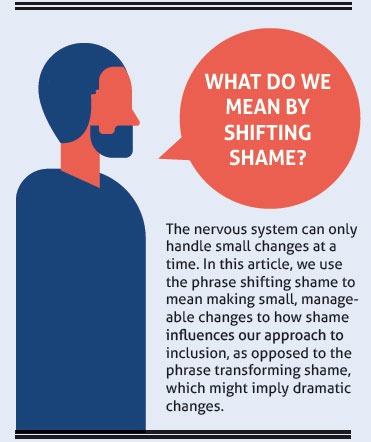As an executive coach to founders, CEOs, and senior executives, I spend my days steeped in dialogue with individuals about team dysfunction, the need to have crucial conversations, and employee stress. Explaining human dynamics in the workplace is what I do best. Inevitably, every conversation finds its way to the concept or concern of belonging, a core issue that is often masked by something that seems much more trivial.
Every single one of us on this planet is wired to want to belong. When we have the experience that we belong, we feel safe. When we have the sense that we belong, we are either sharing a moment of closeness with others or feeling welcomed and accepted into a group. In the moment that we do not feel welcomed, we start to anticipate danger. Our nervous system is constantly scanning for threats. According to Stephen Porges, author of “The Polyvagal Theory,” neuroception is defined as a subconscious system for detecting safety and threats. This is the technical term for belonging.
Neuroception:
a subconscious system for detecting safety and threats
THE OPPOSITE OF BELONGING
When our safety is at risk, we move into protection mode. If over time we continue to feel unsafe in a particular situation or with the same individual, our brain codes this type of interaction as a threat. For example, let’s say someone in a meeting interrupts you. Initially, there is some surprise or confusion on your part. The following week this occurs again. Now, instead of being surprised or confused, you find yourself frustrated or angry. Because it’s a weekly meeting, you are now concerned and walk into the meeting ready to fight or decide that it’s not worth it. Maybe you decide to not speak up and not share your thoughts. Over time, you might dread the meeting and avoid this person altogether. Whichever mode of protection you chose, your brain has coded both this person and the meeting as a threat and has taken you down the road of exclusion. Exclusion is the painful experience when we realize we are not welcomed and accepted for who we are, and therefore we don’t belong. Repeated experiences of exclusion light up the pain centers in the brain and register in the brain as physical injury. So every time you go to this meeting, it’s like being kicked in the shin; it hurts as much.
When we don’t believe that we belong, we may feel many emotions, like anger, frustration, disappointment, sadness, despair, hopelessness, confusion, or even numbness. The emotion at the foundation of not belonging is shame. Research professor and author Brené Brown defines shame as “the intensely painful feeling or experience of believing that we are flawed and therefore unworthy of love and belonging — something we’ve experienced, done, or failed to do makes us unworthy of connection.” Over time, this can play out in the belief that “I am not good enough,” or as imposter syndrome, the persistent inability to believe that one’s success is deserved or has been legitimately achieved as a result of one’s own efforts or skills.
THE POWER OF SHAME
Humans are wired to form relationships. Relationships are designed to keep us safe, protected, and supported. When we attempt to form a relationship from a place of exclusion, we risk infusing it with shame. When we start to infuse shame in a form of communication, we are forming relationships from a place of pain.
Shame is both horrifically devastating and powerfully motivating. Shame is a common denominator that can bring us to our knees. But when harnessed, exacerbated, or spurred, shame can also lead groups to connect, mobilize, and act. It is at this place where people are numb to their shame. When left unchecked, shame wreaks havoc on both the psyche and the nervous system, depleting internal resources and running a constant level of high stress. When the nervous system gets stuck in this place, the individual now sees threat everywhere and with everyone.
From this place, cultivating healthy relationships is incredibly difficult. Relationships become a landscape filled with land mines of instability and unpredictability. Erratic, reactive, and impulsive behavior occurs when the nervous system is on full alert.
THE THREAT OF INCLUSION
In this hyper-vigilant state, it’s incredibly challenging for a person to be mindful, curious, or compassionate. Listening to another person’s ideas or asking clarifying questions is almost impossible, and neglect becomes part of the relationship equation. Any form of neglect is a core driver of shame. Types of neglect can look like being ignored during a conversation or interrupted, dismissed, shut down, humiliated, ridiculed, or ghosted. When neglect and shame are the core tenets of someone’s relationship toolkit, it’s only natural that relationships very quickly become something to either avoid or control. If your primary relationship style is focused on avoiding others, then you might feel incapable of (or proactively denounce) being flexible, open, adaptable, and curious. This makes engaging in inclusive behaviors both a foreign concept and a threat. This is the point where I am often invited to come in and start coaching individuals on the team who might be labeled as bullies, micromanagers, people who never collaborate, or people who don’t listen.
We learn our relationship algorithms as children and bring those lessons into adulthood. Depending on our historical data points, opportunities to grow, and willingness to change, we adapt, shift, or mostly stay the same as adults. So how can we change if we don’t like our relationship algorithm — or someone else’s for that matter?

HOW TO SHIFT SHAME
Those with avoidant relationship styles act as though they are not interested in inclusion as a defense mechanism because they know that being open to inclusion also makes them vulnerable to exclusion. When we focus on shifting shame, we create an opening to inclusion.
In order to shift shame, we must bring our attention back to our neuroception. Everyone’s threshold of belonging may be different, but everyone’s neuroception can be rewired. I define belonging as the ability to create safety for oneself, and as Brené Brown says, “our sense of belonging can never be greater than our level of self-acceptance.”
Shifting shame requires a particular skill set, one that can be developed with diligence, patience, and persistence. It requires willingness to look beyond the mask of what is presented as a problem and connect to what a person is actually seeking.
Not very long ago, I was coaching the “head of people” at a well-known startup. About two months into our coaching, my client asked me to come speak to the people team as well as the CEO about trust. During the meeting, I was explaining the different stages of the nervous system while writing on the white board. All of a sudden, I heard behind me, “Wow, your hand-writing is really shitty.”
Just take a moment to imagine being in the room with all of us. How would you feel hearing that comment? What might you sense in your body? Might you feel some anxiety, discomfort, or curiosity to see how I was going to react?
When I heard this comment, I was certainly surprised and caught off guard. I took a deep breath, slowly turned around to face everyone in the room, looked my client in the eye with a smile, and said, “Tell me what’s going on for you right now.” She replied, “Well, I am frustrated because I can’t read your handwriting and I know what you have to say is valuable. I want to make sure that we’re not wasting anyone’s time today.”
In that one sentence, she told me everything I needed to know. Her frustration indicated to me that she was triggered, and she was feeling excluded because she did not understand what I was trying to convey. She needed a sense of clarity.
To be able to shift shame, one must hone the ability to take a trigger, which is usually masked in exclusion behaviors, and gracefully transition focus to the underlying problem, as I did when I took time out to get an explanation from that client. When we start to sort for needs, we get to the core of the issue. These needs are usually emotional ones: respect, trust, connection, and feeling welcomed and accepted. Needs are the roots of our feelings. When our needs are not met in the moment, our feelings become the indicators that let us know something is amiss.
As we become masterful in surfacing needs during a conversation, we begin to easily shift shame and create a greater sense of belonging for ourselves and others. This skill set is so powerful that it not only rewires the individual’s neuroception over time, but it also begins to allow for the possibility of inclusion during the conversation.
When one’s neuroception is rewired toward inclusion, the nervous system automatically adopts new levels of comfort, ease, and peace. One experiences completely new levels of safety, self-acceptance, and connection within oneself and with others.
Interested in continuing the conversation on racial equity? Make sure to attend SPECTRUM, the premier gathering of multicultural changemakers creating an inclusive impact economy, June 12-13, 2019 at The Gathering Spot in Atlanta, GA.





